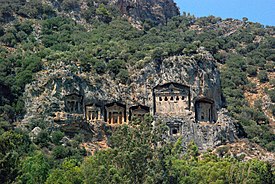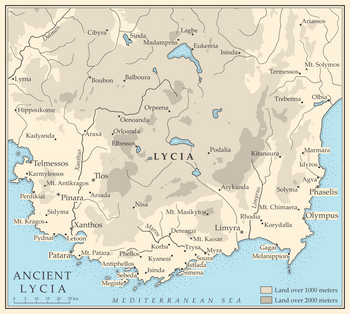
Back Lisië Afrikaans ليقيا Arabic Licia AST Likiya Azerbaijani Лікія Byelorussian Ликия Bulgarian Likia Breton Lícia Catalan Lýkie Czech Lykien Danish
| Lycia Lukka Likya 𐊗𐊕𐊐𐊎𐊆𐊖 (Trm̃mis) Λυκία (Lykia) | |
|---|---|
| Ancient Region of Anatolia | |
 Lycian rock cut tombs of Dalyan | |
| Location | Teke Peninsula, Western Taurus Range, Southern Anatolia, Turkey |
| Languages | Lycian, Greek |
| Successive capitals[citation needed] | Xanthos (Kınık) Patara (Gelemiş) |
| Achaemenid satrapy | Cilicia & Lydia |
| Roman protectorate | Lycian League |
| Roman province | Lycia, then Lycia with other states |
| Byzantine eparchy | Lykia |
 | |

Lycia (Lycian: 𐊗𐊕𐊐𐊎𐊆𐊖 Trm̃mis; Greek: Λυκία, Lykia; Turkish: Likya) was a historical region in Anatolia from 15–14th centuries BC (as Lukka) to 546 BC. It bordered the Mediterranean Sea in what is today the provinces of Antalya and Muğla in Turkey as well some inland parts of Burdur Province. The region was known to history from the Late Bronze Age records of ancient Egypt and the Hittite Empire.
Lycia was populated by speakers of Luwic languages. Written records began to be inscribed in stone in the Lycian language after Lycia's involuntary incorporation into the Achaemenid Empire in the Iron Age. At that time (546 BC) the Luwian speakers were displaced as Lycia received an influx of Persian speakers.
The many cities in Lycia were wealthy as shown by their elaborate architecture starting at least from the 5th century BC and extending to the Roman period.
Lycia fought for the Persians in the Persian Wars, but on the defeat of the Achaemenid Empire by the Greeks, it became intermittently a free agent. After a brief membership in the Athenian Empire, it seceded and became independent (its treaty with Athens had omitted the usual non-secession clause), was under the Persians again, revolted again, was conquered by Mausolus of Caria, returned to the Persians, and finally fell under Macedonian hegemony upon the defeat of the Persians by Alexander the Great. Due to the influx of Greek speakers and the sparsity of the remaining Lycian speakers, Lycia was rapidly Hellenized under the Macedonians, and the Lycian language disappeared from inscriptions and coinage.
On defeating Antiochus III the Great in 188 BC, the Roman Republic gave Lycia to Rhodes for 20 years, taking it back in 168 BC. In these latter stages of the Roman Republic, Lycia came to enjoy freedom as a Roman protectorate. The Romans validated home rule officially under the Lycian League in 168 BC. This native government was an early federation with republican principles; these later came to the attention of the framers of the United States Constitution, influencing their thoughts.[1]
Despite home rule, Lycia was not a sovereign state and had not been since its defeat by the Carians. In 43 AD the Roman emperor Claudius dissolved the league, and Lycia was incorporated into the Roman Empire with provincial status. It became an eparchy of the Eastern, or Byzantine Empire, continuing to speak Greek even after being joined by communities of Turkish language speakers in the early 2nd millennium. After the fall of the Byzantine Empire in the 15th century, Lycia was under the Ottoman Empire, and was inherited by the Turkish Republic on the Dissolution of the Ottoman Empire.
- ^ Bernstein, Richard (19 September 2005). "A Congress, Buried in Turkey's Sand". The New York Times. Archived from the original on 5 September 2012.
© MMXXIII Rich X Search. We shall prevail. All rights reserved. Rich X Search